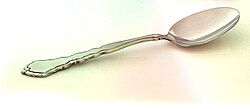Tablespoon


A tablespoon is a type of large spoon usually used for serving. A tablespoonful, an amount approximately equal to the capacity of one tablespoon, is commonly used as a measure of volume in cooking. It is abbreviated in English as T, tb, tbs, tbsp, tblsp, or tblspn. Only the tbs and tbsp abbreviations are currently formally recognized,[1] although the tblsp abbreviation is also commonly used informally. In most countries one level tablespoon is approximately 15 ml. In Australia it is defined as 20 ml.
Variants
When used for solids, such as granulated sugar, it should be measured to the flattened level of the spoon[citation needed]—level spoonful versus a heaping spoonful or heaped tablespoon, which is as much as can be held in the spoon, or a rounded spoonful, which is twice a level spoonful, the solids above the level roughly mirroring those in the bowl.
Common tablespoons intended for use as cutlery (called dessert spoons in the UK, where a tablespoon is always a serving spoon) usually hold slightly less than a tablespoonful.[2]
Relationship to teaspoon and fluid ounce
In most regions (including the United States, Canada, Japan, New Zealand, South Africa, United Kingdom and the Republic of Korea), one tablespoonful equals three teaspoons. In these regions, one tablespoon is approximately 15 mL, which is about 1⁄2 U.S. fl oz. In some places like the U.S., the tablespoon was historically defined as 1⁄2 U.S. fl oz. In Australia a tablespoon is defined as four teaspoons (20 ml). Victorian & Edwardian tablespoons used in the UK are often 25 ml or sometimes larger. They are used only for preparing and serving food, not as part of a place-setting.
In writing volume-based recipes, an abbreviation like tbsp. is usually used, to differentiate it from the smaller teaspoon (tsp.). Some authors additionally capitalize the abbreviation Tbsp., while leaving tsp. in lower case, to emphasize that the larger tablespoon, rather than the smaller teaspoon, is wanted. The tablespoon abbreviation may be even further abbreviated to T in some cases.
Traditional definitions
The traditional U.S. interpretation of the tablespoon as a unit of volume is:[3]
1 U.S. tablespoon = 1⁄2 U.S. fl oz = 4 fluid drams = 1⁄16 U.S. cup = 14.78676478125 mL[4]
This is considered problematic in the context of nutrition labeling, where metric units are used even in the United States.[5] However, this consideration does not lessen the factual relationship of a tablespoon to half of a fluid ounce, and tablespoons can be used to measure ingredients when other measuring devices are unavailable. For instance, 16 tablespoons is equivalent to one cup.
The Australian definition of the tablespoon as a unit of volume is:
- 1 Australian tablespoon = 20 ml or ~⅔ fl. oz.
References
- ^ "tbs - Definition, Merriam-Webster Online Dictionary" Merriam-Webster Online Dictionary(2009). Retrieved on 6 November 2009
- ^ Dean BS, Krenzelok EP (1986 Apr). "Syrup of ipecac dosing ... How much is a tablespoonful?". Vet Hum Toxicol.
{{cite journal}}: Check date values in:|date=(help) - ^ A. Thompson and B. N. Taylor. The NIST Guide for the use of International System of Units. United States Government.
- ^ Mechtly, E. A: The International System of units. NASA-SP=7012, 1964, 1973. The reference indicates the exact conversion to cubic meters, which has been converted to mL here for convenience.
- ^ 21 CFR (Code of Federal Regulations) 101.9(b)(5)(viii)
